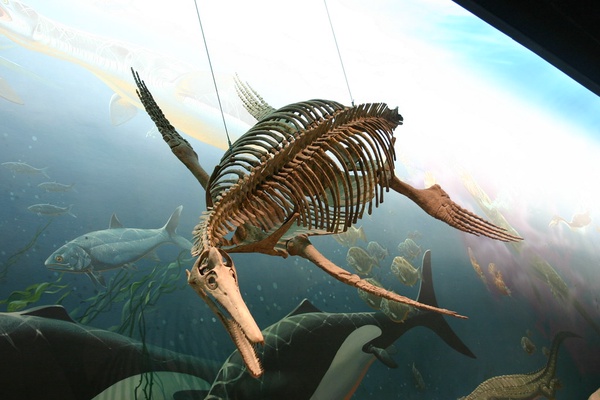‘Sea Dragon’ Fossil discovered in the United Kingdom

Model of an Ichthyosaur
January 22, 2022
In February 2021, a 180-million-year-old fossil of an ichthyosaur has been found in the UK. The fossil was discovered in a reservoir in Rutland, a county in the English East Midlands.
The fossil is an impressive find, considering that it was discovered in areas outside of Yorkshire and southern England coasts, which is where other ichthyosaur fossils have been found in the past. The species went extinct around 90 million years ago, therefore it was alive during the Jurassic period. The fossil of the ichthyosaur measures nearly 33 feet in length and the skull alone is 6 feet, weighing one ton.
“The size and the completeness together is what makes it truly exceptional.” Dean Lomax, lead of the excavation of the fossil, told CNN. The ichthyosaur is known to be an ocean-going reptile. “This was a top of the food chain, apex predator. So, this would have been during on other ichthyosaurs, it would have been eating large fish, it would have eaten, if could catch them, squids as well.” Lomax told CNN.
The fossil was initially found in February of last year in Rutland Water Nature Reserve by Joe Davis, conservation leader from Leicestershire and Rutland Wildlife Trust. Davis was working on some re-landscaping on the land, specifically draining water out of a lagoon, where he saw the vertebrae hiding underneath the mud. Soon, a plan was put together to restore the rare fossil.
“Phase one was lifting the fossil,” said Nigel Larkin, conservator working on the phase 3 part of the excavation. “Phase two will be studying all the hundreds of other specimens we found around the site and also opening up and cleaning a couple of the smaller sections of the skeleton. This will give us a better idea of the coast of phase three, which is fully uncovering the fossil.” Funding for phase one and two came from various organizations, including Rutland County Council, the Rutland and Leicestershire Wildlife Trust, Angelian Water and many more. Funding for phase 3 and the permanent display for the fossil is unsure.
An enormous excavation was held in August and September. Throughout the digging process, the team of paleontologists faced many issues that affected their project. For example: bird poop. The reservoir in which the fossil was found in is a bird sanctuary. Therefore, bird poop was all over the excavation site, making it difficult to shovel through. Another example of an issue is how fragile the bones are. While digging, it was hard to collect all the bones without worrying about breaking them. To help with this issue, the team wrapped the bones in wooden splints encased in plaster to protect it.
According to Lomax, after cleaning the fossil, we may be able to see the ichthyosaur’s last meal or if the dinosaur was pregnant. The fossil discovery could help us find out new groundbreaking discoveries about the ichthyosaur species.
Currently, the fossil is being cleaned and prepared in a lab of paleontological conservator, Nigel Larkin. It will be ready and fully cleaned in the next 18 to 24 months. Regan Harris, spokeswoman for Angelian Water told CNN “We’re very proud of it, and I know the local community are as well. We very much want to bring it home to Rutland and have it on display for people to enjoy.”











